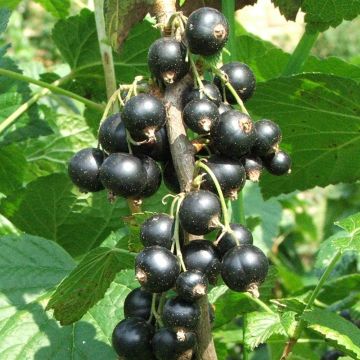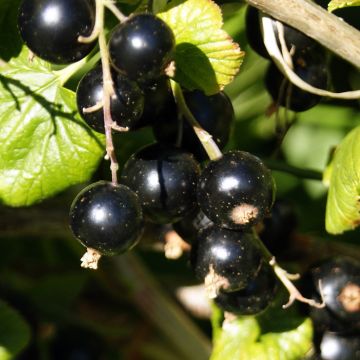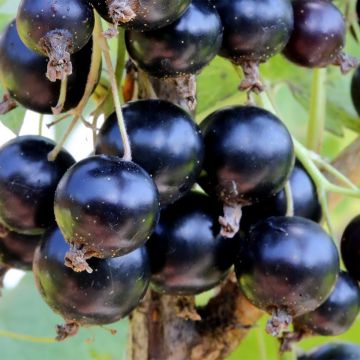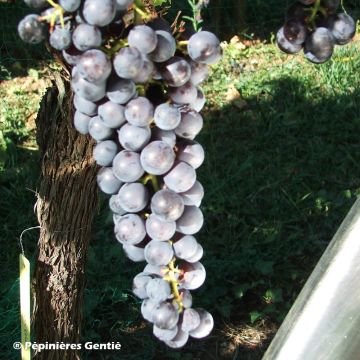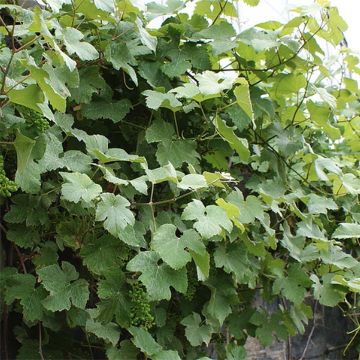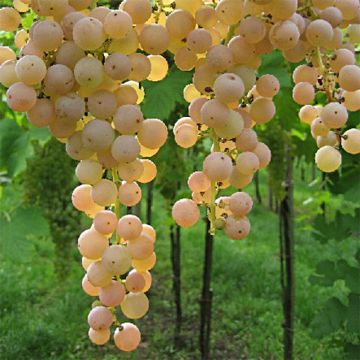

Blackcurrant Noiroma - Ribes nigrum
Blackcurrant Noiroma - Ribes nigrum
Ribes nigrum Noiroma
Blackcurrant
Superbe arbuste très productif aux gros grains pleins de saveur. Très satisfait de cette variété
Jean-Marie, 28/04/2020
Why not try an alternative variety in stock?
View all →This plant carries a 6 months recovery warranty
More information
We guarantee the quality of our plants for a full growing cycle, and will replace at our expense any plant that fails to recover under normal climatic and planting conditions.
From €5.90 for pickup delivery and €6.90 for home delivery
Express home delivery from €8.90.

Description
Blackcurrant 'Noiroma' is a new variety that will make a splash, its large black fruits are particularly sweet and sugary. Only the most delicate palates can discover the unique flavour of blackcurrant as the sugar content in this variety is higher than in any other. This fast-growing variety is self-fertile. Blackcurrants are more often enjoyed cooked than raw and can be used to make juice, jams, or even pies, but the sweeter flavour of 'Noiroma' allows you to incorporate them raw into a fruit salad, for example. Preferably planted in autumn, or in spring with regular watering.
The Blackcurrant (Ribes nigrum) belongs to the Grossulariaceae family, like Gooseberries. It is a deciduous shrub native to regions ranging from the Pyrenees to central Asia. Cultivated since the 16th century, the blackcurrant grows naturally in the cool woods of northeastern Europe.
Fruits appear on 2-year-old branches and become less common on 4-year-old and older branches. Harvest when the fruits are fully black and start to fall on the ground. Wait for the fruits to ripen completely before harvesting them. The 'Noiroma' variety has large fruits the size of small grapes that are harvested in late June. Blackcurrants are rich in tannins and vitamin C and C2. They can be eaten fresh in a mixed berry salad, as juice, syrup, jams or jellies, in pastries (pies, charlottes, and sorbets), or as an accompaniment to savoury dishes. They are also used in the production of liqueurs and nectars. Blackcurrants can be dried or frozen and stored, providing a reserve of fruit for the winter.
The Blackcurrant forms a vigorous bush, with upright tufted habit and few branches, reaching 1.5 metres (5 feet) high with a spread of 1 metre (3 feet). The plant reaches its adult size in three years. It is a very hardy bush, resistant to temperatures as low as -20°C (-4°F) but sensitive to summer drought. The deciduous leaves are large and flat with three to five lobes and toothed edges, bright green and pleasantly fragrant when crushed. Leaves, fruits, and buds are intensely fragrant due to the presence of glands containing essential oils, used in perfumery. The bark is smooth and reddish on young branches and darkens with age.
Flowering occurs in spring, in the form of small bell-shaped flowers that are often inconspicuous. This is followed by large berries with black and shiny skin, gathered in long clusters. While 'Noiroma' is a self-fertile variety and resistant to mildew, the productivity of the bush can be increased by planting another variety nearby. Alternating varieties and species, when space permits, is a good way to promote pollination and reduce the risk of diseases. You can create a small, edible hedge in the garden by mixing Blackcurrants, Gooseberries, and Raspberries, for example, along the edge of a vegetable garden, or place the Blackcurrant within a flowering shrub bed.
Report an error about the product description
Blackcurrant Noiroma - Ribes nigrum in pictures
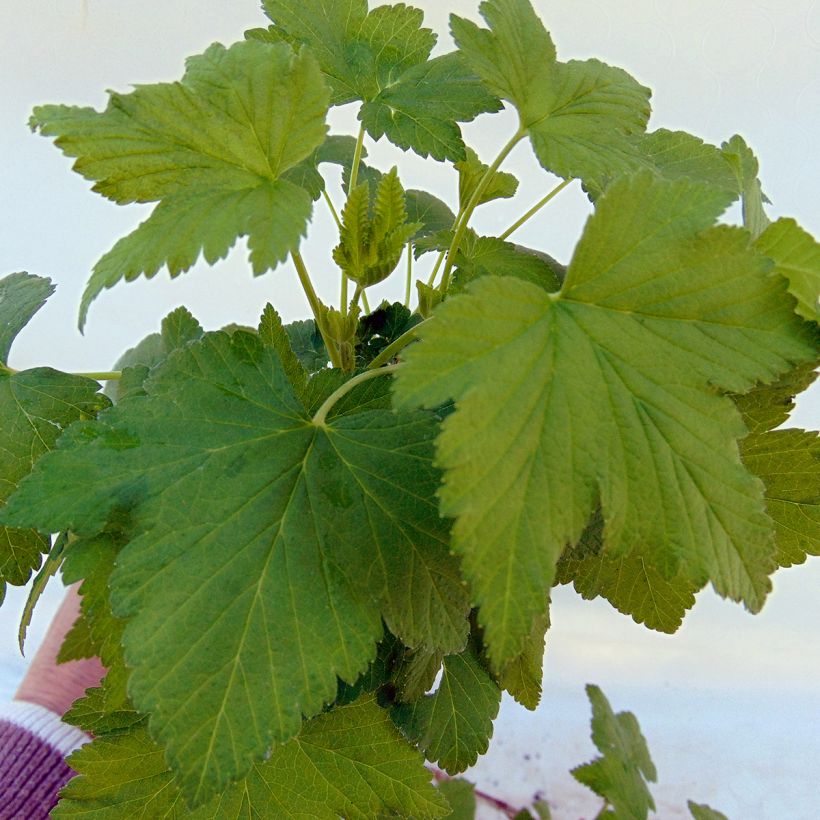



Plant habit
Fruit
Flowering
Foliage
Botanical data
Ribes
nigrum
Noiroma
Grossulariaceae
Blackcurrant
Cultivar or hybrid
Other Blackcurrant bush
Planting and care
Plant the Blackcurrant bush in autumn, or spring with regular watering, in ordinary, deep, even heavy and clayey soil. It likes moist soils if they are not constantly wet. A non-direct sun exposure, or partial shade, in a sheltered place from strong winds, will yield good results. The Blackcurrant bush indeed fears heat and drought.
If you plant multiple Blackcurrant bushes, space them 1 m (3ft) apart in all directions. Soak the root ball in water for a few moments before planting. Dig a hole, incorporate compost and bonemeal into the soil, place the young plant burying the collar and cover with soil. Water regularly during the first year after planting and then only in high temperatures. Apply mulch around the base to retain moisture in summer. Add some compost every year, in spring or autumn. Do not dig the soil too much as the Blackcurrant bush has shallow roots.
It is an accommodating bush, and 'Noiroma' is a mildew-resistant variety. It has a few enemies, such as aphids, which can be eliminated by spraying soapy water or a garlic decoction. In June-July, protect the harvest with nets to deter birds.
If space allows, it is important to alternate varieties, in a Blackcurrant plantation as in any plantation. This will aid pollination, even for self-fertile varieties, and limit the risk of disease.
Planting period
Intended location
Care
-
, onOrder confirmed
Reply from on Promesse de fleurs
Berries
Haven't found what you were looking for?
Hardiness is the lowest winter temperature a plant can endure without suffering serious damage or even dying. However, hardiness is affected by location (a sheltered area, such as a patio), protection (winter cover) and soil type (hardiness is improved by well-drained soil).

Photo Sharing Terms & Conditions
In order to encourage gardeners to interact and share their experiences, Promesse de fleurs offers various media enabling content to be uploaded onto its Site - in particular via the ‘Photo sharing’ module.
The User agrees to refrain from:
- Posting any content that is illegal, prejudicial, insulting, racist, inciteful to hatred, revisionist, contrary to public decency, that infringes on privacy or on the privacy rights of third parties, in particular the publicity rights of persons and goods, intellectual property rights, or the right to privacy.
- Submitting content on behalf of a third party;
- Impersonate the identity of a third party and/or publish any personal information about a third party;
In general, the User undertakes to refrain from any unethical behaviour.
All Content (in particular text, comments, files, images, photos, videos, creative works, etc.), which may be subject to property or intellectual property rights, image or other private rights, shall remain the property of the User, subject to the limited rights granted by the terms of the licence granted by Promesse de fleurs as stated below. Users are at liberty to publish or not to publish such Content on the Site, notably via the ‘Photo Sharing’ facility, and accept that this Content shall be made public and freely accessible, notably on the Internet.
Users further acknowledge, undertake to have ,and guarantee that they hold all necessary rights and permissions to publish such material on the Site, in particular with regard to the legislation in force pertaining to any privacy, property, intellectual property, image, or contractual rights, or rights of any other nature. By publishing such Content on the Site, Users acknowledge accepting full liability as publishers of the Content within the meaning of the law, and grant Promesse de fleurs, free of charge, an inclusive, worldwide licence for the said Content for the entire duration of its publication, including all reproduction, representation, up/downloading, displaying, performing, transmission, and storage rights.
Users also grant permission for their name to be linked to the Content and accept that this link may not always be made available.
By engaging in posting material, Users consent to their Content becoming automatically accessible on the Internet, in particular on other sites and/or blogs and/or web pages of the Promesse de fleurs site, including in particular social pages and the Promesse de fleurs catalogue.
Users may secure the removal of entrusted content free of charge by issuing a simple request via our contact form.
The flowering period indicated on our website applies to countries and regions located in USDA zone 8 (France, the United Kingdom, Ireland, the Netherlands, etc.)
It will vary according to where you live:
- In zones 9 to 10 (Italy, Spain, Greece, etc.), flowering will occur about 2 to 4 weeks earlier.
- In zones 6 to 7 (Germany, Poland, Slovenia, and lower mountainous regions), flowering will be delayed by 2 to 3 weeks.
- In zone 5 (Central Europe, Scandinavia), blooming will be delayed by 3 to 5 weeks.
In temperate climates, pruning of spring-flowering shrubs (forsythia, spireas, etc.) should be done just after flowering.
Pruning of summer-flowering shrubs (Indian Lilac, Perovskia, etc.) can be done in winter or spring.
In cold regions as well as with frost-sensitive plants, avoid pruning too early when severe frosts may still occur.
The planting period indicated on our website applies to countries and regions located in USDA zone 8 (France, United Kingdom, Ireland, Netherlands).
It will vary according to where you live:
- In Mediterranean zones (Marseille, Madrid, Milan, etc.), autumn and winter are the best planting periods.
- In continental zones (Strasbourg, Munich, Vienna, etc.), delay planting by 2 to 3 weeks in spring and bring it forward by 2 to 4 weeks in autumn.
- In mountainous regions (the Alps, Pyrenees, Carpathians, etc.), it is best to plant in late spring (May-June) or late summer (August-September).
The harvesting period indicated on our website applies to countries and regions in USDA zone 8 (France, England, Ireland, the Netherlands).
In colder areas (Scandinavia, Poland, Austria...) fruit and vegetable harvests are likely to be delayed by 3-4 weeks.
In warmer areas (Italy, Spain, Greece, etc.), harvesting will probably take place earlier, depending on weather conditions.
The sowing periods indicated on our website apply to countries and regions within USDA Zone 8 (France, UK, Ireland, Netherlands).
In colder areas (Scandinavia, Poland, Austria...), delay any outdoor sowing by 3-4 weeks, or sow under glass.
In warmer climes (Italy, Spain, Greece, etc.), bring outdoor sowing forward by a few weeks.

































